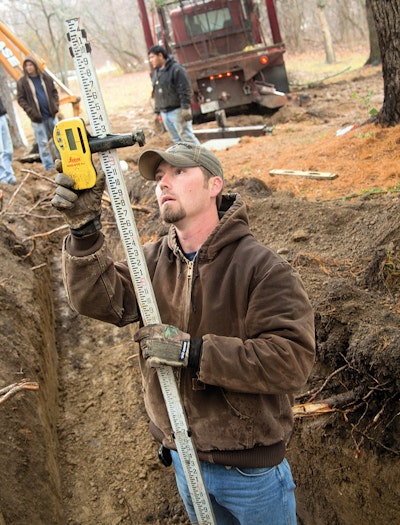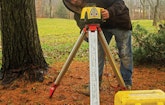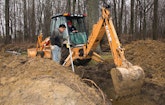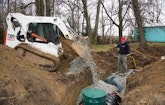
Interested in Systems/ATUs?
Get Systems/ATUs articles, news and videos right in your inbox! Sign up now.
Systems/ATUs + Get AlertsWhat advice would Brian Baker, of B. Baker Construction in Noblesville, Ind., give to contractors about persevering during lean times, such as after the housing bubble burst several years ago?
“Stay in your comfort zone and resist the temptation to overextend during the good times,” says Baker, whose company – started in 1986 – found ways to prosper into a solid position and look forward to better days ahead.
Trained as an automotive mechanic, Baker was soon swept off course, finding his life’s passion in onsite systems. “I wanted to know the answer to any septic question, so I studied the regulations for each county in which I worked,” he says. “Helping people was how I grew my niche in the industry.”
HOMEWORK PAYS OFF
Today, the company is licensed in Hamilton, Madison, Marion, Boone, Johnson, Hendricks and Tipton Counties. While the main focus is on installing or repairing residential and commercial onsite systems, other services include septic tank pumping, sewer and driveway installations, pond construction, and decorative concrete and crawl space footings.
Running an auto repair business at night while working for a car dealership during the day introduced Baker to self-employment. A stint doing everything but the billing for an excavation contractor laid the groundwork for a great leap of faith. When the owner wanted to sell a used J.I. Case backhoe, Baker bought it.
“I’d been purchasing the smaller stuff I’d need to start my business – a truck and trailer, pumps, compactors, cutoff saws – everything I could afford, while working for somebody else,” says Baker. “When the bank lent me $100,000, I was scared to death and couldn’t sleep that night. The monthly payments were more than a thousand dollars. In the 1980s, that much money was a house payment for many people.” Baker, 25 at the time, also had house payments and a new wife.
The one job Baker had on the board when he bought the backhoe turned into another before he finished digging the hole. He went anywhere and did anything for anybody, but mostly he excavated for sewer or water mains with an occasional septic system in the mix. Work snowballed and he hired his first employee within two years.
In 1991, Indiana updated its septic code. Counties took the minimum mandates and enacted them as they saw fit. Studying their different regulations became a passion for Baker. The most radical change required drainfields larger than 1,500 square feet to be flood dosed (one dose equals the designed capacity of the system). At the time, installing basic gravity systems was easy, and half the farmers with backhoes did it to earn extra income.
However, the new code required installers and service providers to be licensed, and Baker was one of the first. He retains his certification through the Indiana Onsite Waste Water Professionals Association and attends as many onsite wastewater conferences as possible.
SEPTIC IS BREAD AND BUTTER
To help clients find him, Baker bought a medium-sized display ad in the phone book. “It was expensive, but it opened doors,” he says. “I got a lot more calls from many different directions, but mostly we became known for troubleshooting septic systems.”
About 80 percent of the company’s annual revenue came from the septic industry, and mainly through referrals. As workload grew, Baker’s mind told him to buy more machines and hire more employees. He analyzed his financial situation and business prospects, then decided he would never owe more than $100,000.
“I found it really tough to stay in my zone, working with what I had and could afford,” he says. “I always forced myself to pay off one machine before buying another, and each machine had to pay for itself.”
Baker’s mechanical ability enabled him to keep machines longer, but he always upgraded equipment before it lost trade-in value. He buys Case equipment for excavation work, and stores, repairs and paints everything in an 80- by 80-foot shop on 17 acres. His wife, Rachael, one of the company’s four employees, runs the home office.
Baker purchased a John Deere bulldozer to complement his backhoe. Now he graded properties after installing systems and even offered to reseed as an extra service. “I restrained the company’s growth until the funds were available to make my life and jobs easier,” he says.
Another challenge was not accepting projects beyond the company’s capabilities. Baker resisted the temptation because it wasn’t right for him, and he didn’t want to hire subcontractors. “I prefer to stay in my zone and keep the machines in my zone,” he says. “However, every contractor must make that decision for himself.”
NEW REVENUE STREAMS
Then a customer prompted Baker into commercial onsite system installation. A general contractor hired him to install a Wisconsin sand mound for a new fire station. As soon as the state approved the technology, Baker learned everything about it. County health departments liked mounds for commercial properties and Baker’s expertise put him in position to build that specialty. He repeated this formula whenever the state approved another technology.
In 2000, employee Frank Powers gave Baker his notice with plans to start a pumping business, Powers Septic and Sewer in Noblesville. The move worked out well for both contractors.
“Now I could offer that service to my customers and Frank shared some of his service calls with me,” says Baker. “I also call Frank to jet drainfield laterals and break up biomats as part of our service work, which includes pumps, floats, electrical and replacing or rehabilitating absorption beds.”
Baker provides five-year maintenance contracts on the advanced treatment systems his company installs, and he hired a technician to fulfill them and handle standard service calls. “The state mandates service contracts for the life of these systems,” says Baker. “I chose five years to avoid renewing them every other year.”
INSPECTION DEMAND
While the state does not require onsite inspections for real estate transfers, the abundance of homes in foreclosure created another business opportunity for Baker. Home inspectors evaluating these properties also include the onsite systems, passing or failing them based solely on a dye test. Baker gets a lot of calls to provide the service.
Besides the dye test, Baker’s technicians use a Sludge Judge sampler from Cole-Parmer to measure settled solids. In 2010, Baker bought a RIDGID SeeSnake to help troubleshoot problems discovered during inspections. To help customers make informed decisions, he also offers a septic investigation. “I explain that a system dormant for four years could pass the test, but easily fail once a family moves into the home,” says Baker.
A septic inspection for a 450-gpd system would involve dosing it three times with 150 gallons of water within 24 hours. Each phase includes measuring the scum layer, adding water, then the dye, measuring again and inspecting the absorption area for surfacing effluent. “Any time effluent leaves the tank or breaks out, the test is over and the system has failed,” says Baker. “Noting how quickly the system recovers from phase one usually tells us if it will pass or fail.”
THINNING THE HERD
While the housing bubble inflated, Hamilton County Health Department wrote 450 to 480 permits a year and Baker installed 30 to 40 of those systems. In 2009, the county issued 60 permits and Baker installed four systems. “When the bottom dropped out, I was in a stable position because I had not overextended myself when things were good,” he says. “Hamilton isn’t a big county and I knew all my competitors. Five of them have since closed their doors.”
Baker said the construction slowdown weeded out marginal contracting companies. “Everyone was buying backhoes and calling themselves contractors,” he says. “There was so much new construction that even contractors with bad reputations could stay in business. When the work went away, so did they, and customers benefited from it.”
Today, referrals generate most of Baker’s business or people find him through the company’s website or the service provider rating site, Angie’s List. While new installs are gradually returning – he did 17 in 2012 – drainfield repairs, drainage work, snow removal and salting keep everyone busy. “Last year’s drought was a blessing for many onsite systems,” says Baker. “Then spring rains and snowmelt made them show their ugly faces again. As soon as soils dried sufficiently, we were out there repairing them.”
CONTINUING EDUCATION
Repairs have migrated from replacing stone-and-pipe drainfields with recirculating gravel filters to installing Bio-Microbics FAST systems purchased from nearby Clear Water Environmental Solutions.
As new technologies enter the onsite arena, Baker intends to be at the forefront, learning all he can, sharing his knowledge and helping customers improve their chances of living with happy septic systems.











